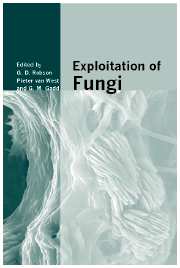Book contents
- Frontmatter
- Contents
- List of contributors
- Preface
- I Comparative and functional fungal genomics
- II Bioactive molecules
- III Protein folding and secretion
- 7 The role of microtubules and motors for polarized growth of filamentous fungi
- 8 The cellular response to protein unfolding stress
- 9 Protein secretion and associated stresses in Aspergillus: a genomic perspective
- IV Fungal bioremediation
- V Fungal biocontrol of pests
- Index
- References
8 - The cellular response to protein unfolding stress
from III - Protein folding and secretion
Published online by Cambridge University Press: 05 October 2013
- Frontmatter
- Contents
- List of contributors
- Preface
- I Comparative and functional fungal genomics
- II Bioactive molecules
- III Protein folding and secretion
- 7 The role of microtubules and motors for polarized growth of filamentous fungi
- 8 The cellular response to protein unfolding stress
- 9 Protein secretion and associated stresses in Aspergillus: a genomic perspective
- IV Fungal bioremediation
- V Fungal biocontrol of pests
- Index
- References
Summary
Introduction
Yeast and fungi are important for the production of industrial and therapeutic proteins (Tables 8.1 and 8.2). Product titres can reach several g/l, e.g. for human serum albumin expressed in Pichia pastoris (~7 g/l) (Kobayashi et al., 2000) or cellobiohydrolase expressed in Trichoderma reesei (~20 g/l) (Durand, Clanet & Tiraby, 1988; Nakari-Setälä & Penttilä, 1995). However, in most cases product titres are ~1000-fold lower (Archer, Jeenes & Mackenzie, 1994; Penttilä, 1998; Cereghino & Cregg, 2000). Identification and engineering of the bottleneck in these, usually heterologous, protein production processes will increase their cost efficiency and competitiveness.
The first bottlenecks that were identified were gene copy number (Clare et al., 1991; McGrew et al., 1997; Vassileva et al., 2001) and transcription efficiency (Outchkourov, Stiekema & Jongsma, 2002). Both were overcome by increasing gene dosage (Clare et al., 1991; Parekh, Forrester & Wittrup, 1995; McGrew et al., 1997; Vassileva et al., 2001) and optimization of codon usage (Gouka, Punt & van den Hondel, 1997a; Kraševec, van den Hondel & Komel, 2000; Moralejo et al., 2000; Outchkourov et al., 2002; Cardoza et al., 2003). Reports emerged stating that with increased gene copy number protein production decreased (Parekh et al., 1995). Recombinant protein was shown to remain associated with the cell (Hohenblum, Borth & Mattanovich, 2003) and localized to the endoplasmic reticulum (ER) (Kauffman et al., 2002). Thus, protein folding and posttranslational modification in the ER are a major bottleneck for protein secretion.
- Type
- Chapter
- Information
- Exploitation of Fungi , pp. 117 - 139Publisher: Cambridge University PressPrint publication year: 2007
References
- 6
- Cited by



